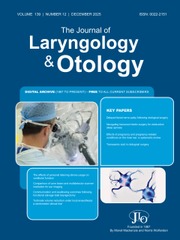No CrossRef data available.
Article contents
The characteristic of conventional and extended high-frequency audiometry in older adults – a community-based investigation in South China
Published online by Cambridge University Press: 10 April 2025
Abstract
To define extended high-frequency hearing threshold ranges in normal hearing elderly (aged 55 years and above) and identify associated risk factors for extended high-frequency hearing loss.
Pure-tone thresholds (0.25–16 kHz) and word recognition scores were measured using portable audiometric equipment. Lifestyle and medical histories were collected, and generalised linear models analysed risk factors for extended high-frequency hearing (10–12 kHz).
In normal hearing elderly (28 ears, 18 subjects), 95 per cent confidence intervals for 10 and 12 kHz were 34.770–49.301 and 56.976–65.809, respectively. Among 342 ears (200 subjects), hypertension emerged as a leading risk factor for extended high-frequency hearing loss, while lipid-lowering medications showed potential protective effects.
Preliminary extended high-frequency hearing thresholds were established, with hypertension identified as a key risk factor and lipid-lowering medications as a potential protective factor.
Information
- Type
- Main Article
- Information
- Copyright
- © The Author(s), 2025. Published by Cambridge University Press on behalf of J.L.O. (1984) LIMITED.
Footnotes
Equal first authors
The data that support the findings of this study are available upon reasonable request.

